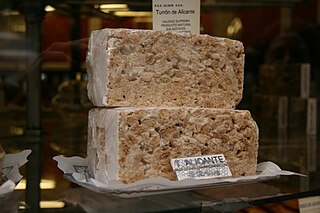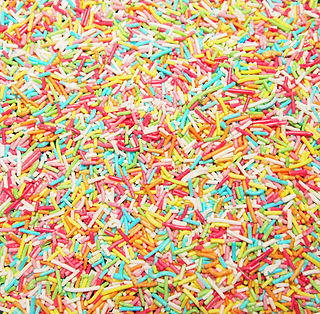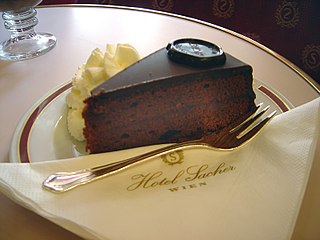
Cake is a flour confection made from flour, sugar, and other ingredients and is usually baked. In their oldest forms, cakes were modifications of bread, but cakes now cover a wide range of preparations that can be simple or elaborate and which share features with desserts such as pastries, meringues, custards, and pies.

Pavlova is a meringue-based dessert. Originating in either Australia or New Zealand in the early 20th century, it was named after the Russian ballerina Anna Pavlova. Taking the form of a cake-like circular block of baked meringue, pavlova has a crisp crust and soft, light inside. The confection is usually topped with fruit and whipped cream. The name is commonly pronounced pav-LOH-və or pahv-LOH-və, and occasionally closer to the name of the dancer, as PAHV-lə-və.

Pralines are confections containing nuts – usually almonds, pecans and hazelnuts – and sugar. Cream is a common third ingredient.

Turrón, torró and torrone is a southwest European and Moroccan nougat confection, typically made of honey, sugar, and egg white, with toasted almonds or other nuts, and usually shaped either into a rectangular tablet or a round cake. Turrón is usually eaten as a dessert food around Christmas in Spain, and Italy. It's also known in Portugal, Morocco, and Latin America.

Marzipan is a confection consisting primarily of sugar, honey, and almond meal, sometimes augmented with almond oil or extract.

Gingerbread refers to a broad category of baked goods, typically flavored with ginger, cloves, nutmeg, and cinnamon and sweetened with honey, sugar, or molasses. Gingerbread foods vary, ranging from a moist loaf cake to forms nearly as crisp as a ginger snap.

Sprinkles are small pieces of confectionery used as an often colourful decoration or to add texture to desserts such as brownies, cupcakes, doughnuts or ice cream. The tiny candies are produced in a variety of colors and are generally used as a topping or a decorative element. The Dictionary of American Regional English defines them as "tiny balls or rod-shaped bits of candy used as a topping for ice-cream, cakes and other."

Sachertorte is a chocolate cake, or torte, of Austrian origin, invented by Franz Sacher, supposedly in 1832 for Prince Metternich in Vienna. It is one of the most famous Viennese culinary specialties.

Red velvet cake is traditionally a red, crimson, or scarlet-colored layer cake, layered with ermine icing. Traditional recipes do not use food coloring, with the red color possibly due to non-Dutched, anthocyanin-rich cocoa, and possibly due to the usage of brown sugar, formerly called red sugar.

Baumkuchen is a kind of spit cake from German cuisine. It is also a popular dessert in Japan. The characteristic rings that appear in its slices resemble tree rings, and give the cake its German name, Baumkuchen, which literally translates to "tree cake" or "log cake".

A Swiss roll, jelly roll, roll cake, cream roll, roulade or Swiss log is a type of rolled sponge cake filled with whipped cream, jam, icing, or any type of filling. The origins of the term are unclear; in spite of the name "Swiss roll", the cake is believed to have originated elsewhere in Central Europe, possibly Austria or Slovenia. It appears to have been invented in the nineteenth century, along with Battenberg cake, doughnuts, and Victoria sponge. In the U.S., commercial snack-sized versions of the cake are sold with the brand names Ho Hos, Yodels, Swiss Cake Rolls, and others. A type of roll cake called Yule log is traditionally served at Christmas.

Chocolate cake or chocolate gâteau is a cake flavored with melted chocolate, cocoa powder, or both. Chocolate cake is made with chocolate. It can also include other ingredients. These include fudge, vanilla creme, and other sweeteners.

Peppermint bark is a chocolate confection. Generally it consists of peppermint candy pieces, such as candy canes, in white chocolate on top of dark chocolate, but peppermint bark can refer to any chocolate with peppermint candy pieces in it.
The following outline is provided as an overview of and topical guide to chocolate:

Sponge cake is a light cake made with eggs, flour and sugar, sometimes leavened with baking powder. Some sponge cakes do not contain egg yolks, like angel food cake, but most of them do. Sponge cakes, leavened with beaten eggs, originated during the Renaissance, possibly in Spain. The sponge cake is thought to be one of the first non-yeasted cakes, and the earliest attested sponge cake recipe in English is found in a book by the English poet Gervase Markham, The English Huswife, Containing the Inward and Outward Virtues Which Ought to Be in a Complete Woman (1615). Still, the cake was much more like a cracker: thin and crispy. Sponge cakes became the cake recognised today when bakers started using beaten eggs as a rising agent in the mid-18th century. The Victorian creation of baking powder by English food manufacturer Alfred Bird in 1843 allowed the addition of butter to the traditional sponge recipe, resulting in the creation of the Victoria sponge. Cakes are available in many flavours and have many recipes as well. Sponge cakes have become snack cakes via the Twinkie.

















